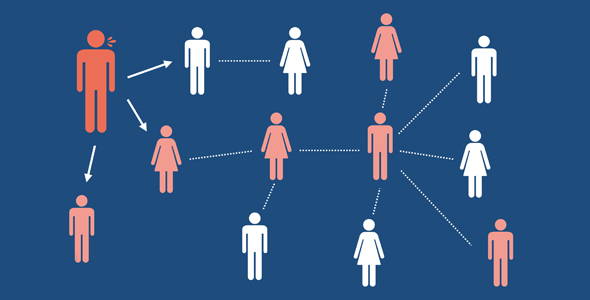By the bioMérieux Connection Editors
The COVID-19 pandemic has brought many public health terms into the mainstream: “social distancing”, “flattening the curve”, and more recently, “contact tracing”. Many states have announced that contact tracing will be utilized in their COVID-19 management efforts, and the director of the CDC has stated that contact tracing is key to halting the spread of the virus.
Contact tracing is the process of working with an infected patient to help them recall everyone with whom they have had close contact, then, warning the exposed individuals of their potential exposure and providing education, information, and encouragement to stay home and maintain distance from others. The CDC defines ‘close contact’ as coming within 6 feet of an infected person for at least 15 minutes, starting from 48 hours before illness onset until the time the patient is isolated. Identifying close contacts and ensuring they do not interact with others is critical to prevent further spread of the virus.
Contact Tracing: Examples in Recent History
Contact tracing is a core infection control measure that has been employed by public health officials around the world for decades. One of the largest contract tracing efforts in history occurred in Liberia during the 2014 Ebola virus disease (EVD) epidemic. Contact tracers were hired and chosen from within the community to investigate each Ebola case and track down all known individuals who had contact with that person. Contact tracing was critical in ending the outbreak. Dr. Raj Panjabi, who helped set up contact tracing teams, states in a recent NPR article, “We couldn’t break the chain of transmission and drive the epidemic down to zero cases in Liberia without contact tracing.”
Contact tracing was also instrumental in eradicating smallpox in the 1970s, alongside thorough vaccination efforts. Smallpox formed a rash on those infected, was fatal in up to 30% of cases, and was highly contagious. When a person with smallpox was identified, they were quarantined, and all the people in their surrounding community were immunized. This method continued until smallpox was eventually reduced to isolated outbreaks and then eradicated altogether.
What Is Necessary for Effective Contact Tracing?
To be done effectively, contact tracing requires people with specialized training, adequate supervision, and access to social and medical support for patients and contacts. Contact tracers are in part, public health workers, as well as investigators. The CDC has stated that the time to start building a trained workforce of contact tracers is now—some experts estimate that the U.S. needs around 100,000 tracers in order to manage COVID-19 outbreaks.
Where will this workforce come from? Panjabi argues that health officials can utilize the growing number of Americans who are finding themselves out of work due to the effects of the virus. “One possible way is they actually hire Americans who’ve been unemployed by this pandemic and put them to work,” he says.
The Role of Technology in Contact Tracing
Contact tracing is a laborious process—interviewing patients and then locating and reaching out to dozens of contacts takes time. Technology, including apps and location tracking, have the potential to supercharge those efforts; however, health officials are leaning towards more traditional, person-to-person contact tracing methods. Tom Frieden, the former head of the CDC, provides an easy motive for traditional contact tracing: the human bond. “It means actually talking to someone and answering their questions, addressing their needs and concerns, and building, earning, and maintaining their trust and confidentiality.”
Confidentiality is another major concern for contact tracing technology, specifically when linked with smart phones. The abuse of data and privacy has made headlines repeatedly over the last decade as smart technology has evolved, and any location data collected by contact tracing apps would carry the same types of risks. Contact tracing apps, like all apps, have the potential to not be secured sufficiently, be poorly designed, or be hacked, allowing patient data to enter the data market, where it can be accessed by anyone.
While contact tracing apps may not be widely accepted by health officials, the CDC does advocate for the adoption of emerging technologies that can assist health practitioners with client communication and medical monitoring. There is a need for analytic management tools that can help automate parts of the contact tracing process and include automated reports to aid in monitoring progress and outcomes.
Contact Tracing Will Be Crucial in COVID-19 Outbreak Management
Because contact tracing is a time-consuming process, it works best when there are low levels of infection in a community. When there are a lot of people infected, it can quickly overwhelm the ability of contract tracers to be able to track down all individuals. As the U.S. looks to contain the virus and simultaneously reopen the economy, contact tracing can help ensure that those who are potentially infected do not infect others. As of May 7, according to an NPR survey, 44 states and the District of Columbia have plans to expand their contact tracing workforce, reaching a total of 66,197 workers.
Scott Gottlieb, former FDA chief, is pleased with the states’ response to contact tracing initiatives, saying, “We already see the states making efforts to bring on thousands of new public health workers to do contact tracing. We’re going to need this number of people if we want to enter into the fall with the kinds of resources we need to try to trace infection to prevent large outbreaks.”
Opinions expressed in this article are not necessarily those of bioMérieux, Inc.




I think this is the only way forward, to get out of this mess. I say contact traceing, is a worthy effort.